Affiliate disclosure: This post may contain affiliate links. Please see our Privacy Policy.
Pear wine is a simple way to preserve the flavor of fresh pears in a delightful homemade wine.
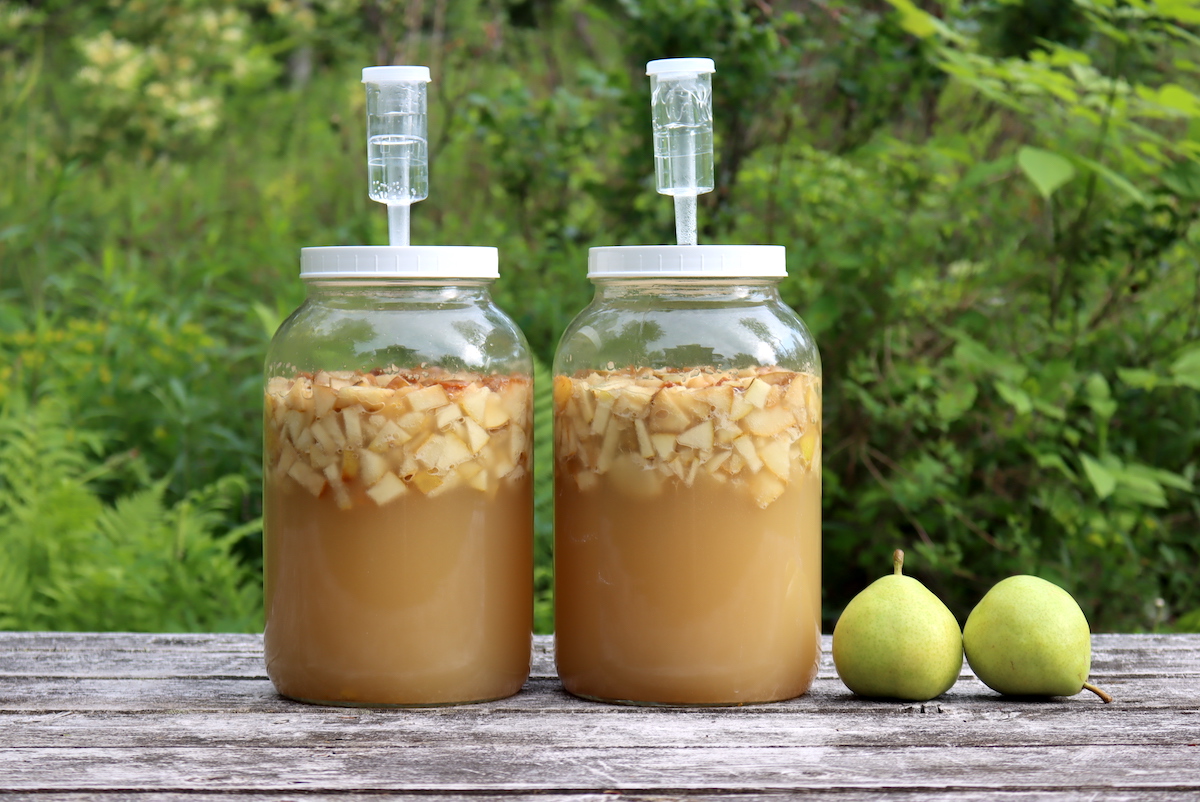
Pears have an absolutely luscious flavor that works exceptionally well in homemade wine, and pear wine is easy to make, even for beginners. It’s even better than apple wine in my opinion, as pears tend to be a lot more aromatic.
Pear wine is different than pear hard cider, or “perry.”
Perry requires specific cider pears to create a balanced drink, and you actually have to work pretty hard to find old-fashioned perry pears with enough acidity and tannin to get the job done. Even still, it usually ends up quite dry since pears just don’t have nearly enough natural sugar to satisfy the yeast, and still leave enough after fermentation.
Pear wine, on the other hand, can be made with any type of pear because you’re going to add acidity, sugar, and tannin to create a perfect balance. Whether it’s sweet or dry depends on your choices because you as the winemaker are controlling all the ingredients.
All you really need to make pear wine is high-quality, flavorful pears to provide a base. (You can also use pear juice, either fresh pressed or commercially bottled.)
Basic Steps for Making Fruit Wine
If you’ve never made fruit wine, I’m going to cover the basic steps, mostly so you understand the terminology.
- Primary Fermentation: Place ingredients in a fermentation vessel (including yeast) and allow the mixture to ferment for about 7 to 10 days. Be sure the mixture is at room temperature when the yeast is added. This is the most active and vigorous fermentation and produces a lot of sediment.
- Rack Into Secondary Fermentation: Use a siphon to move the wine to a clean fermentation vessel. Filter out any fruit chunks and leave the sediment behind.
- Secondary Fermentation: Fermented in a narrow neck fermentation vessel (carboy), this fermentation is slower and less vigorous. The wine finishes fermenting during this period, and the yeast slows down until they die out. Sediment slowly settles out, so the wine clarifies. Secondary lasts 4 weeks to 4 months, depending on your preference. Longer tends to improve flavor.
- Bottling: After secondary fermentation, it’s time to bottle the wine in wine bottles with corks. Taste the wine at this point, and if it’s too dry for your tastes, add a bit of sugar made into simple syrup and move the wine into a carboy for another 1 to 2 weeks, then proceed to bottling. Once in the bottle, the wine should bottle condition for a minimum of 2 weeks, but more like 2 months is better.
Equipment you’ll need includes:
- A single two-gallon fermentation bucket, or two one-gallon wide mouth fermentation vessels (for primary fermentation)
- One narrow neck fermentation vessel (also called a carboy or demijohns) for secondary fermentation
- Airlock and plug (this often comes with the carboy, above)
- Brewing Siphon
- Wine Bottle Corker
- New Wine Bottle Corks
- Clean Empty Wine Bottles
Ingredients for Pear Wine
- 5 lbs pears, seeded and finely chopped
- 3 quarts of water (12 cups)
- 4 cups white sugar (2 lbs)
- 1 cup brown sugar (1/2 lb)
- Juice of 2 lemons (1/2 cup)
- 1/4 tsp tannin powder (optional, you can add 1 cup of strongly brewed black tea instead)
- 1 tsp yeast nutrient (Strongly recommended, but you can add 1/4 cup of raisins instead to feed the yeast)
- 1 tsp pectic enzyme (optional, helps clarify the wine by breaking down fruit pectin)
- 1 packet of wine yeast (I’m using Champagne Yeast for a neutral finish)
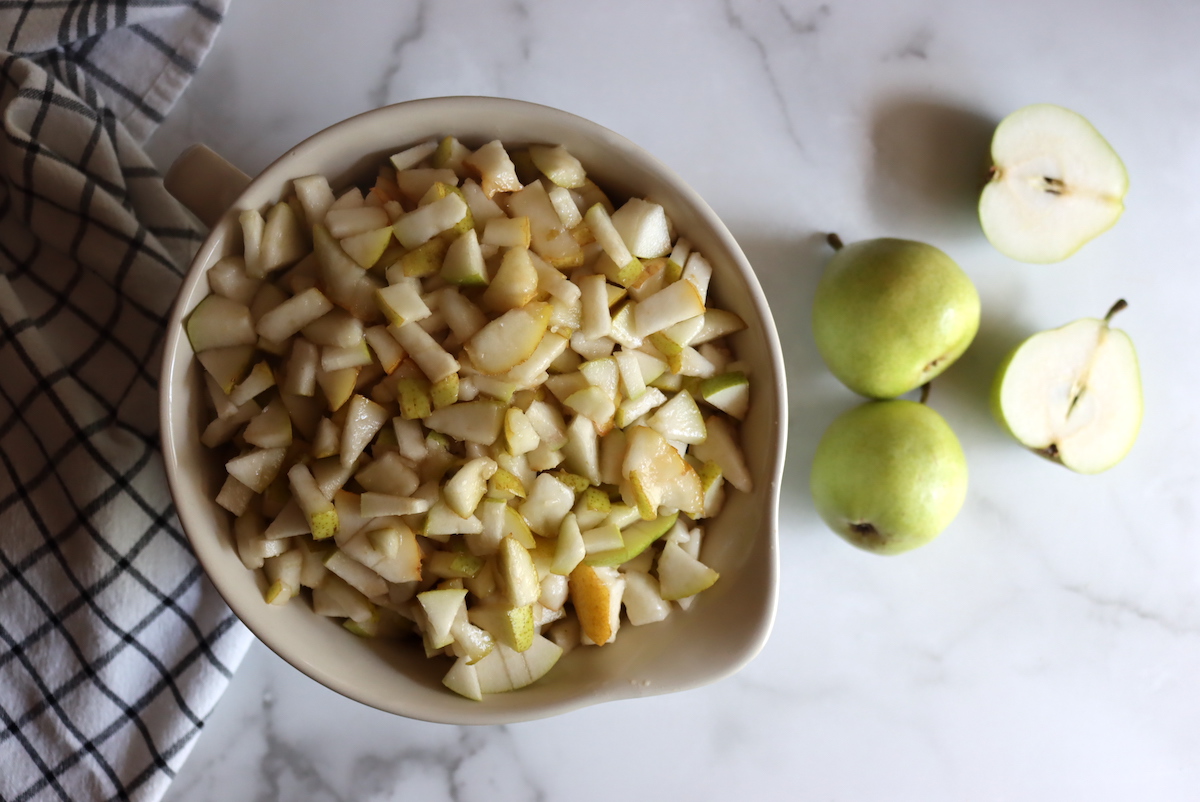
If you’re making pear wine with juice, skip the water and the chopped pears, just add enough pear juice to fill the carboy.
When making pear wine with whole fruit, you’ll need to start with a 2-gallon fermentation bucket or divide the primary fermentation across two wide-mouth one-gallon fermentation jugs (as I’ve done). Once the pears are filtered out everything will fit in a standard 1-gallon narrow neck fermentation vessel.
When making pear wine from juice, you can just start in a 1-gallon fermentation vessel since the bulky chopped pears won’t take up extra space.
Choosing Yeast for Pear Wine
Wine yeast, believe it or not, actually contributes a lot of flavor to the finished wine.
Some types of yeast add fruity flavors, others ferment cleaner with minimal added flavors. Some have very high alcohol tolerances, like champagne yeast, and will ferment very dry unless you add a lot of extra sugar.
For pear wine, choose a wine yeast with moderate alcohol tolerance, that either ferments clean or adds light fruit flavors.
Good yeast choices include:
- Red Star Premier Cuvee, Red Star Premier Blanc, or Lavin EC-1118: Often referred to as champagne yeasts, these are robust fermenters known for their neutral flavor profile. With an alcohol tolerance of up to 18%, these yeasts can handle higher sugar levels, which is why this recipe provides enough sugar to support this active yeast while still leaving some residual sweetness.
- Lavin D47: This yeast brings a vibrant fruity and floral profile, contributing spicy aromas that can add depth to apple wine. It’s a moderately active fermenter that may begin slowly, but its alcohol tolerance reaches up to 15%.
- Lalvin QA23: Commonly selected for white wines, this yeast helps produce a clean, fruity flavor with a quick fermentation process. It settles out quickly, aiding in wine clarity. Its alcohol tolerance is up to 16%.
I’m using champagne yeast (Red Star Premier Blanc) for this batch, and if you choose a yeast with lower alcohol tolerance, reduce the sugar by about 1/4 pound (or 1/2 cup) or expect a sweeter wine at the end.
One packet of wine yeast is sufficient for 5 gallons of wine, so you won’t need to use the entire packet. While the exact amount isn’t critical, as the yeast will multiply quickly, aim to use about 1/5 to 1/2 of the packet for a gallon of juice.
To begin, dissolve the yeast in a small amount of water and let it rehydrate for about 10 minutes to ensure it’s active. Adding it directly to the apple juice can shock the yeast due to the sugar content, so it’s best to allow them to wake up first.
Yeast packets typically come with clear instructions, and some varieties (like liquid yeast) may have slightly different requirements. Be sure to follow the directions on the packet for the best results.
(It’s important to avoid using bread yeast! It will give your wine a yeasty, bread-like flavor. And, of course, bread yeast isn’t designed for long ferments or the high-sugar environment of wine, leading to off-flavors as it struggles to adapt.)
How to Make Pear Wine
To make pear wine, start by chopping and coring the fruit. There’s no need to peel the fruit, unless you specifically want to. A lot of pear flavor and aromatics are in the peel.
I would suggest using organic fruit though and washing the fruit thoroughly. (Or, you can choose to play it safe and peel them, as pears are generally a high spray crop.)
When you start with about 5 lbs of fresh pears, it’ll end up being about 4 quarts of fruit, chopped, seeds removed but not peeled.
Four quarts is a full gallon, so that’s not going to fit into a simple one-gallon carboy with the other ingredients. Generally, primary fermentation of fruit wines with chunky fruit pieces is done in a 2-gallon fermentation bucket, which gives plenty of space for all the ingredients plus extra headspace.
Primary fermentation is vigorous, and you don’t have to use an airlock during that stage. You can just cover the bucket and allow it to open ferment, just keeping a cloth over the top to keep out flies/debris.
After primary fermentation, you use a siphon to move the pear wine to a closed fermenter that has a one-way valve (air lock) that will allow the CO2 from the yeast out, but not allow any contaminants in (namely, acetic acid bacteria that can turn your wine to vinegar).
I happen to have two wide-mouth one-gallon fermentation vessels, so I just split the batch across two of those instead. Having a water lock on for this first week is optional, but it does keep things neat and clean (and I don’t have to worry at all about contamination).
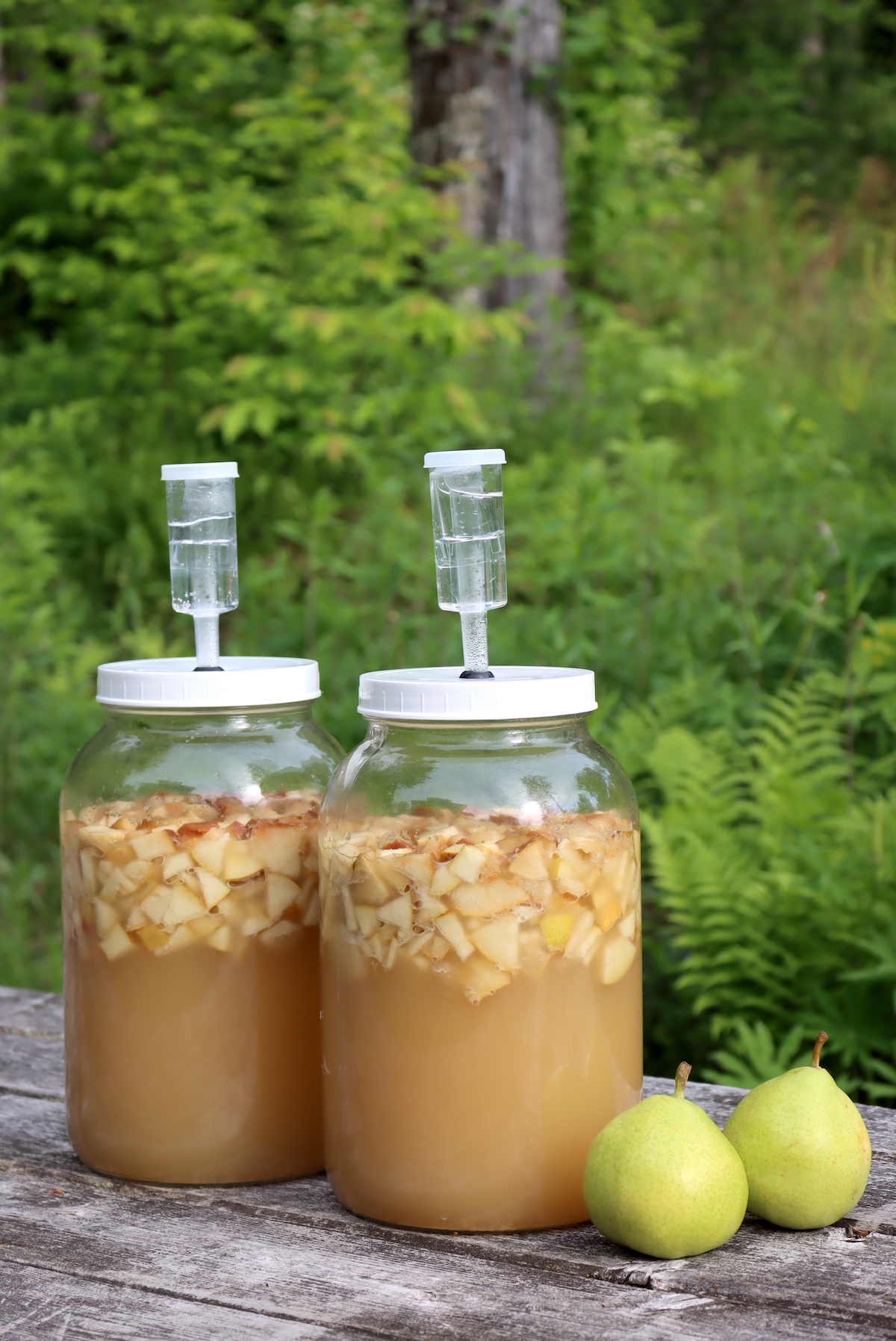
If you’re using two containers, as I am, split all the ingredients in half evenly across both. Otherwise, just put everything in a single larger container.
Bring 12 cups of water to a simmer on the stove and add the sugar, stirring to dissolve. Allow the sugar to cool to room temperature.
Add the sugar water, chopped pears, lemon juice, yeast nutrient, and tannin powder to the fermentation vessel (or vessels). Double-check that the mixture is at about room temperature (70 to 90 degrees F). If it’s too hot, the yeast will die.
Dissolve the packet of yeast in a small amount of water, and allow it to “bloom” for about 5 to 10 minutes. This gives the yeast time to wake up before they’re added so they don’t shock.
Add the dissolved yeast to the mixture.
Cover with a towel to keep flies/debris out of the mixture. Do not cap tightly, the fermentation will put off CO2 as the yeast work, and that needs to escape.
Allow the mixture to ferment for 7 to 10 days until things settle down a bit. Once the fermentation isn’t quite so vigorous, use a sciphon to move the mixture to a narrow neck carboy for secondary fermentation.
At this point, the fruit is removed. Some people opt to use brewing bags to hold the fruit, which makes straining it out much easier. That’s optional, but really nice and makes things a lot cleaner.
Either way, get all the solids out when you move it to secondary, and leave the yeasty sediment behind. The sediment at the bottom is dead yeast that wore itself out during primary, and in winemaking, it’s referred to as “lees.” Wine left on the “lees” too long can develop off-flavors, that’s one reason moving to a clean container for secondary is important.
Cap the secondary fermenter with an air lock (sometimes also called a water lock). It’s a one-way valve that lets CO2 escape from the fermentation but doesn’t let contaminants into your pear wine.
Allow the wine to ferment in the secondary fermentation vessel with an airlock for about 4 weeks. That’s a minimum, and longer is fine, provided you keep water in the airlock to keep things sealed up. Leaving it 4 to 6 months will improve the clarity and quality of the finished wine.
Once secondary is complete, bottle the wine in wine bottles with corks. Taste it at bottling time, and it should taste a bit rough, but you’re evaluating sweetness here.
If the wine is too dry, make up a bit of simple syrup and add it to the mixture, then allow the wine to ferment for another week or two before trying again and bottling.
Allow the pear wine to bottle condition for a minimum of 2 weeks before drinking, preferably 2 months or more. Longer will increase quality and mellow the flavors so it tastes more “finished.” Young wines tend to taste a bit “rough around the edges.”
Pear Wine Recipe Variations
Other Pear Wine Recipes
This is my pear wine recipe, and I think it works out wonderfully, but I’m going to walk you through some of the other options found in all the winemaking books on my shelf.
Ways to Preserve Pears
Looking for more ways to preserve pears?
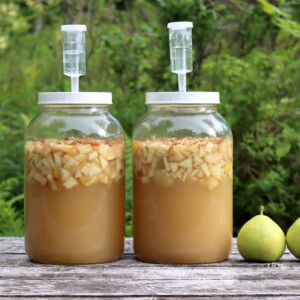
Pear Wine
Ingredients
- 5 lbs pears, seeded and finely chopped
- 3 quarts water, 12 cups
- 4 cups Sugar, 2 lbs
- 1 cup brown sugar, 1/2 lb
- 1/2 cup lemon juice, from about 2 fresh lemons
- 1/4 tsp tannin powder
- 1 tsp yeast nutrient
- 1 tsp Pectic Enzyme
- 1 packet wine yeast, see notes
Instructions
- Start by sanitizing all equipment.
- Bring 12 cups of water to a gentle simmer on the stove and dissolve the sugar and brown sugar in the hot water, stirring until it's completely dissolved. Allow the mixture to cool to room temperature.
- Chop and seed the pears, leaving the skins on. Place them in your wide mouth fermentation vessel, either a single 2 gallon bucket or divided evenly across two one gallon wide mouth fermentation jars.
- Add the remaining ingredients (except yeast), including sugar water, lemon juice, yeast nutrient and tannin powder. Stir to incorporate.
- Dissolve the yeast packet in a small amount of room temperature water. Allow the yeast to rehydrate for 5 to 10 minutes, then add them into the pear/sugar/water mixture. Be sure to leave 2-3 inches of headspace to allow the mixture to bubble.
- Cover the mixture with a towel to keep out flies/debris, or seal with a water lock if you're using wide-mouth fermenters that can accommodate that. Be sure to leave plenty of headspace at this stage, the pears can bubble up into the waterlock and make a big mess.
- Allow the mixture to ferment in "primary fermentation" with the fruit in the mixture for 7 to 10 days.
- Once fermentation starts to slow, use a sciphon to transfer just the liquid portion to a narrow neck fermenter for secondary. Leave the yeast sediment and fruit pulp behind.
- Allow the mixture to ferment in secondary for at least 4 weeks, but up to 4 to 6 months.
- Once fermentation is complete, taste the wine to test for sweetness (it'll taste rough at this point, but you're evaluating residual sugar). If you want a sweeter wine, make a simple syrup by dissolving a small amount of sugar in water. Add the simple syrup and allow the mixture to ferment for another 1 to 2 weeks before bottling.
- To bottle, siphon the wine into wine bottles and seal with corks.
- Allow the pear wine to bottle age for at least 2 weeks before drinking, but preferably 2 months or longer. The longer you wait, the better the wine will taste. Fruit wines taste a bit "rough" when young, but they'll mellow with time.
Notes
Wine Yeast
The alcohol tolerance of the wine yeast will determine the residual sugar in the wine (or sweetness when finished). Wine yeast can also contribute flavor to the finished wine. I'm using champagne yeast because it's a dependable fermenter with a neutral taste, but it has a high alcohol tolerance (around 18%). If you choose a yeast with lower alcohol tolerance, reduce the sugar by about 1/4 pound (or 1/2 cup), or expect a sweeter wine at the end. If you specifically want a sweeter wine, opt for yeast with a lower alcohol tolerance (13 to 15%). Lavin D47 is a good choice, as is Lavin QA43. See the article for a more in-depth discussion of wine yeasts.Nutrition
Nutrition information is automatically calculated, so should only be used as an approximation.
Winemaking Recipes
Pears aren’t the only fruit you can make into wine at home!
Fermented Beverages
Keep your carboy bubbling with these…
- How to Make Mead (Honey Wine)
- How to Make Hard Cider
- How to Make Tepache (Pineapple Scrap Drink)
- How to Make Water Kefir
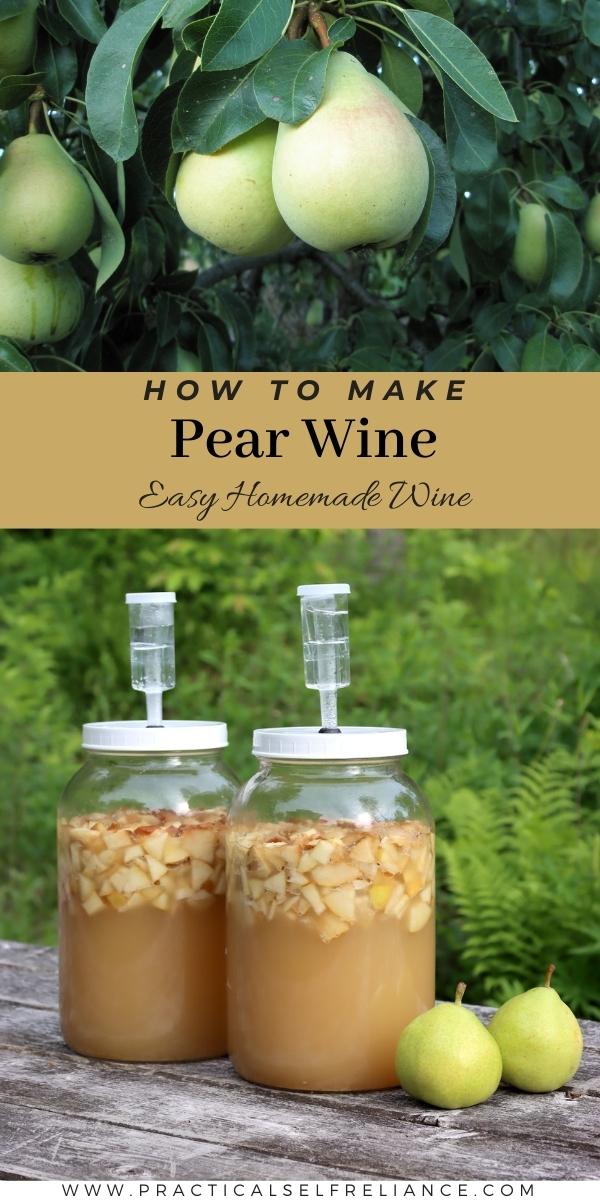


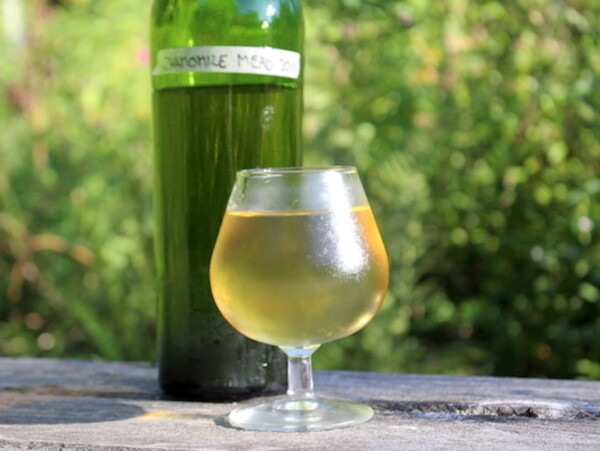
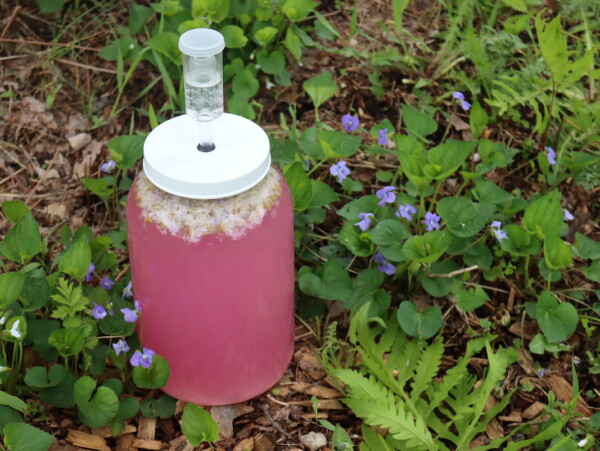










Hi, Ashley. Can I use two 1.5 gallon wide mouth fermenter jars or will there be too much headspace? Thank you.
You can for primary fermentation, but you’ll want to move them into something narrow mouth for secondary. Enjoy!
I’ve made Ashley’s peach, pear And blackberry wine. Very easy to follow instructions, especially for someone that’s never done anything like this. I have bottled the peach and pear wine and did my second racking of the blackberry wine. I’ve tasted all three and they taste great. My favorite has to be the pear wine. All three are sweet, but this one is very delightful. I’m going to enjoy all three, but I’m definitely glad I made 5 gallons of this one which produced 17 bottles of wine.
Thank you so much for sharing. We’re so glad you enjoyed the recipes.
For this pear wine recipe are you supposed to use the whole yeast packet? That’s what the instructions sound like. I know the packet is good for up to 5 gallons. I’m working on this right now and ready to add the yeast.
In the blog portion of this post, it explains that you can just use 1/5 to 1/2 a packet of the yeast. If you used a full packet it should be just fine though.
I’m going to try this recipe (and wine making) for the first time. I bought pectin enzyme but I don’t see how you used it in the recipe?
Thanks
Julie
If you’re using pectic enzyme in this recipe, you would use 1 tsp and add it in at step 4 in the recipe instructions.
Hello, Ashley! I’m following your instructions to make my first batch of pear wine. It says to remove all the solids when the wine is siphoned to the carboy but in your photo you have pear chuncks in the carboy. Are those fresh pear pieces or from the first fermentation process? Or should I add no fruit at all? Just don’t want to mess this up! Thanks!
That picture is the primary fermentation. When you get ready for the secondary fermentation you will remove the solids when racking into the secondary container.
Do you know ingredient quantities for a larger batch?
We made this recipe for the first time last summer and it was absolutely delicious! We started out small, but this year we’re hoping to maximize our yield. We’d like to fill a 5-gallon carboy.
Thank you so much for this recipe! Everyone keeps asking for more pear wine this year and we’re excited to make another batch!
You can just multiply all the ingredients by 5 except for the wine yeast. One packet will do up to 5 gallons.
Hi Ashley! Thank you so much for your lovely website and awesome pear wine recipe. I shredded the pears (after seeding) in my food processor, and used a vanilla bean during fermentation. I left the vanilla bean in until bottling the wine, and you could tasted the subtle hints of vanilla. Finished wine was 12.2% ABV and delicious!
Also, thank you for not using sulfites. I’ve only found a couple of websites and books which do not use them. When I first starting making wine 2 years ago, I added the campden to a couple of batches, but have not done that since. Other then their paranoia about killing everything, I have yet to really understand why people insist on using it. I always ensure that my work area is very clean, and I do sanitize everything with StarSan/Easy Clean; no one has ever gotten sick from my homemade wine (and mead), and I’ve probably bottled 30 gallons so far. I thought maybe they’re afraid of exploding bottles. I haven’t had that issue as I ferment down to a very dry wine and do not over-sweeten. I’m also supposing that perhaps the wine must be drunk sooner with no sulphites added? I’ve read that homemade fruit wine should be drunk within a year, but so far, nothing I’ve made has made it that long, lol.
The purpose of the sulfites is to stabilize the wine and stop fermentation. This is a process that actually stops on its own naturally if you’ve used the right yeast and balanced your recipe. Alcohol is shelf stable all on its own so I’m not sure how adding sulfites could make a difference on the shelf life but if it doesn’t last a year anyway, I guess it doesn’t matter that much does it?
Yes, thanks. I stop the ferment once the gravity is below 1.0, and my understanding is that there is no more fermentation after that point anyway. I’ve also read where folks use sulfites to “sterilize” the wine, but it never made sense to me. Thanks again.
You’re welcome.
I am about to make pear wine for the first time. I saw how you press pears to make cider (juice). And I was going to use a meat grinder to break them down and then press the juice out and use that juice to make the wine. On this recipe it says to seed and core the pears bc the seeds will kinda ruin a pear wine. I wonder if I used the meat grinder to mash them before juicing them do I need to still core and seed them? I have a bad wrist right now and am trying to lessen the manual labor.
The bitter flavor will still remain if you grind the seeds. They really do need to be removed.
I’ve started the recipe and it looks promising. I didn’t have lemons so I went with lemon juice. I somewhat unthinkingly added the full 1/2 cup and realized too late that that is much more than 2 lemons worth! The pH of my wine is around 2.9, which is quite low but the yeast is doing fine.
I’m worried the roughly 6 grams of citric acid in the lemon juice will spoil into acetic acid. We’ll see how it turns out. It smells amazing after a week of fermenting.
Hello!
I am going to give this a try with my bumper crop of pears. Question: If I double the ingredients (pears, water, sugar) do I also double the tannin powder, yeast nutrient, pectin enzyme and yeast?
Yes, except for the yeast. One packet of yeast is enough for 5 gallons of wine.
This is not a recipe for self reliance! How many commercial products are in the recipe? I have ripe pears and yeast in an old pickle jar. Cross your fingers folks. I will also look for a wine recipe from the 18th century when everyone was self reliant.
Most of the commercial ingredients are optional so you are completely welcome to leave them out if you wish by following the suggestions listed in the post for substitutions.
Very practical, John. Very practical.